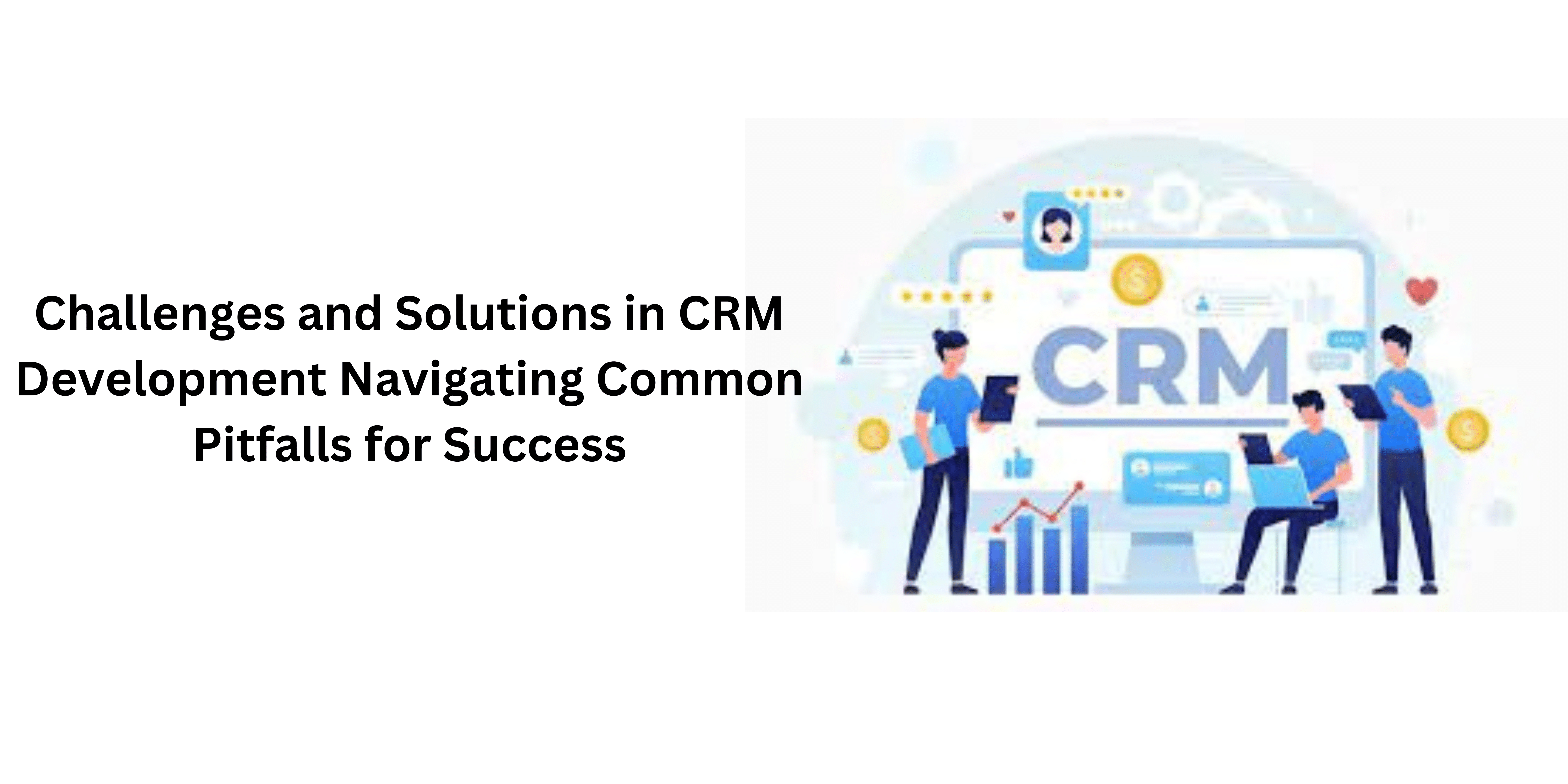In the dynamic realm of business, Customer Relationship Management (CRM) development stands as a crucial element in fostering lasting connections with customers. However, this journey is not without its challenges, requiring a nuanced understanding of pitfalls and proactive strategies for success.
This article delves into the multifaceted landscape of CRM development, exploring common hurdles and effective solutions to navigate them. As organizations strive to align their business goals with CRM objectives, the selection of the right platform, data security considerations, and integration challenges become paramount.
The delicate balance between customization and out-of-the-box solutions, coupled with issues of user adoption and scalability, further shape the trajectory of CRM projects. Join us on an insightful exploration of the challenges inherent in CRM development, as we unravel the intricacies and provide actionable insights for overcoming obstacles, ensuring not just the development of robust CRM systems, but their sustained success in the ever-evolving business ecosystem.
Understanding the Landscape: Common Challenges
In the intricate landscape of CRM development, a comprehensive understanding of the common challenges is essential for devising effective strategies and ensuring successful implementations. One prevalent challenge lies in the alignment of business goals with CRM objectives. Organizations must intricately weave CRM solutions into their overarching strategies, harmonizing customer-centric initiatives with broader operational targets.
The choice of a suitable CRM platform is another pivotal consideration. With a plethora of options available, selecting a platform that seamlessly integrates with existing systems, meets specific business needs, and allows for future scalability is a nuanced task. Data security remains a constant concern, particularly in an era marked by stringent privacy regulations. Safeguarding sensitive customer information is paramount, necessitating robust security measures and compliance with data protection standards.
Integration challenges arise when attempting to synchronize CRM systems with pre-existing software. Smooth interoperability is critical to avoid disruptions in data flow and maintain a unified organizational infrastructure. User adoption and training hurdles add another layer of complexity, as the success of a CRM system heavily depends on how well it is embraced and utilized across the organization.
Scaling CRM solutions to accommodate growing business requirements without compromising efficiency poses a considerable obstacle. Striking the right balance between customization and out-of-the-box solutions is crucial, ensuring that the CRM system aligns with unique organizational processes while remaining adaptable to evolving industry standards. In this exploration of CRM development challenges, the aim is not only to identify these obstacles but also to illuminate effective solutions, providing a roadmap for businesses to navigate the complexities and harness the full potential of CRM technologies.
Aligning Business Goals with CRM Objectives
The seamless integration of Customer Relationship Management (CRM) objectives with overarching business goals stands as a cornerstone in the success of any CRM development initiative. Aligning these elements ensures that the CRM system becomes a strategic enabler rather than a standalone tool. At its core, the alignment process requires a meticulous examination of organizational objectives, customer-centric initiatives, and the role of CRM in enhancing overall business performance.
Firstly, organizations must articulate clear and measurable business goals. Whether the focus is on revenue growth, customer retention, or market expansion, these objectives serve as guiding beacons for CRM implementation. The CRM strategy, facilitated by custom CRM development services, should be intricately woven into these goals, acting as a catalyst for achieving desired outcomes.
Next, understanding customer-centric objectives becomes imperative. CRM, at its essence, revolves around building and nurturing relationships with customers. Identifying customer engagement metrics, satisfaction levels, and the overall customer journey aids in tailoring CRM functionalities to address these specific objectives.
The synergy between business and CRM objectives also involves creating a framework for data-driven decision-making. By aligning CRM processes with the need for actionable insights, organizations can leverage customer data to inform and optimize their broader strategies.
In this symbiotic relationship, CRM becomes more than a technology solution; it becomes a strategic partner in achieving organizational success. Regular assessments and recalibrations are essential to ensure that CRM objectives evolve in tandem with shifting business priorities. Through this alignment, businesses not only harness the full potential of CRM systems but also forge a path toward sustained growth and competitiveness in today’s dynamic market landscape.
Choosing the Right CRM Platform
Selecting the right Customer Relationship Management (CRM) platform is a pivotal decision that significantly influences the success of CRM development initiatives. The market offers a plethora of options, each with its unique features, capabilities, and suitability for different business needs. Making an informed choice involves a comprehensive evaluation of various factors to ensure the selected platform aligns seamlessly with organizational objectives.
One critical consideration is the scalability of the CRM platform. An ideal choice should not only meet current business requirements but also have the flexibility to adapt and expand as the organization grows. The ability to integrate with existing systems is equally crucial to avoid disruptions in data flow and maintain operational continuity.
Customization capabilities play a vital role in tailoring the CRM system to specific business processes. The chosen platform should offer sufficient flexibility to accommodate unique workflows and requirements, enabling organizations to maximize the utility of the CRM solution.
User-friendliness is another key factor. A CRM platform that is intuitive and easy to navigate fosters higher user adoption rates across the organization. Adequate training resources and support mechanisms should complement the platform to empower users in effectively leveraging its functionalities.
Considerations for data security and compliance with industry regulations are non-negotiable. Organizations must prioritize platforms that uphold stringent security standards to protect sensitive customer information and ensure legal compliance.
Moreover, assessing the vendor’s reputation, reliability, and long-term support services is essential. An established track record of successful implementations and ongoing support demonstrates the vendor’s commitment to the client’s success.
In conclusion, the process of choosing the right CRM platform demands a meticulous evaluation of scalability, integration capabilities, customization options, user-friendliness, data security, and vendor reliability. A well-informed decision in this regard lays a robust foundation for the effective implementation and utilization of CRM systems, supporting businesses in cultivating enduring customer relationships and achieving strategic objectives.
Data Security Concerns in CRM Development
Data security concerns in CRM development are paramount, given the sensitive nature of customer information and the increasing prevalence of cyber threats. As organizations leverage CRM systems to centralize and manage vast amounts of customer data, ensuring the confidentiality, integrity, and availability of this information becomes a critical imperative.
One major challenge revolves around safeguarding against unauthorized access. Robust authentication mechanisms, role-based access controls, and encryption protocols, integral to custom CRM software development, are essential components in fortifying CRM platforms against potential breaches. Regularly updating and patching system vulnerabilities further reinforces the security posture.
Another concern is the risk of data breaches during transmission. Employing secure communication protocols such as HTTPS and encrypting data in transit help mitigate these risks. Additionally, organizations should prioritize secure storage practices, implementing encryption for data at rest to safeguard against unauthorized access to stored information.
Compliance with data protection regulations, such as GDPR, HIPAA, or other industry-specific standards, is a non-negotiable aspect of CRM development. Ensuring that CRM systems adhere to these regulations not only protects organizations from legal ramifications but also fosters customer trust by demonstrating a commitment to privacy and ethical data handling.
Furthermore, organizations must be vigilant in monitoring and auditing CRM activities. Implementing comprehensive logging mechanisms allows for the detection of unusual patterns or suspicious activities, enabling swift responses to potential security incidents.
Educating employees on data security best practices is an integral aspect of overall CRM security. Human error remains a significant factor in data breaches, and training programs contribute to a culture of awareness and responsibility.
In essence, addressing data security concerns in CRM development requires a multi-faceted approach, encompassing technological safeguards, regulatory compliance, proactive monitoring, and continuous employee education. By prioritizing data security, organizations not only protect sensitive customer information but also fortify the foundation of trust upon which successful customer relationships are built.
Integration Challenges with Existing Systems
Integrating a new Customer Relationship Management (CRM) system with existing organizational systems presents a complex set of challenges that demand strategic planning and technical finesse. Seamless integration is crucial to ensure a unified and streamlined flow of data across the enterprise. Common integration challenges in CRM development often revolve around compatibility, data synchronization, and mitigating disruptions to ongoing business operations.
Compatibility issues arise when attempting to connect the CRM system with existing software, databases, or legacy systems. Differences in data formats, protocols, or application programming interfaces (APIs) can impede smooth integration. In addressing this challenge, organizations need to conduct a thorough assessment of existing systems, ensuring that the CRM platform is compatible and can effectively communicate with diverse technologies.
Data synchronization is another critical concern. Maintaining consistency and accuracy across integrated systems is essential for informed decision-making. Real-time synchronization, facilitated by the expertise of a custom CRM development company, is particularly vital to ensure that the latest and most relevant information is available across the organization. Organizations must establish robust data mapping processes and implement efficient synchronization mechanisms to overcome this challenge.
Mitigating disruptions during the integration process is imperative to avoid downtime and operational setbacks. A phased implementation approach, starting with non-critical systems and gradually expanding integration, can minimize disruptions. Comprehensive testing at each integration stage helps identify and rectify potential issues before full deployment.
In conclusion, successfully overcoming integration challenges in CRM development requires meticulous planning, a clear understanding of existing systems, and a systematic approach to implementation. By addressing compatibility issues, ensuring seamless data synchronization, and minimizing disruptions, organizations can realize the full benefits of a well-integrated CRM system, enhancing operational efficiency and facilitating informed decision-making.
User Adoption and Training Hurdles
User adoption and training hurdles represent critical challenges in the successful implementation of Customer Relationship Management (CRM) systems. While CRM technology offers immense potential for enhancing customer interactions and business processes, its effectiveness hinges on the extent to which users embrace and leverage its functionalities.
One significant obstacle is resistance to change among users. Employees accustomed to existing workflows may be hesitant to embrace new technologies, fearing disruptions to established routines. To overcome this, organizations need comprehensive change management strategies that involve clear communication, highlighting the benefits of the CRM system, and addressing concerns proactively.
Effective training programs are essential to empower users with the skills and knowledge needed to navigate and utilize the CRM platform optimally. Training should be tailored to different user roles and levels of technical proficiency, ensuring that each user understands their specific responsibilities within the CRM system.
Another challenge lies in the diverse needs of users across an organization. A one-size-fits-all approach to training may not be suitable. Instead, organizations, with the assistance of custom CRM developers, should offer varied training formats, including in-person sessions, online modules, and user guides, allowing individuals to choose the method that best suits their learning preferences.
Continuous support and feedback mechanisms play a pivotal role in sustaining user adoption. Establishing helpdesk services, creating user communities, and providing ongoing resources contribute to a culture of support, enabling users to overcome challenges and maximize their proficiency with the CRM system.
In conclusion, addressing user adoption and training hurdles requires a comprehensive approach that encompasses change management, tailored training programs, and ongoing support mechanisms. By fostering a positive and user-friendly environment, organizations can cultivate a workforce that not only embraces CRM technology but also actively contributes to its success in driving improved customer relationships and organizational efficiency.
Scalability Issues in CRM Solutions
Scalability issues in Customer Relationship Management (CRM) solutions pose significant challenges for organizations aiming to adapt their CRM systems to evolving business needs. Scalability refers to the system’s ability to handle an increasing volume of data, users, or transactions without compromising performance or functionality. Recognizing and addressing scalability concerns is crucial for ensuring that a CRM system can grow alongside the organization it serves.
One common scalability challenge arises when an organization experiences rapid growth in customer data. As the volume of customer information expands, the CRM system must seamlessly scale to accommodate the increased load without sacrificing speed or responsiveness. Insufficient scalability can lead to performance bottlenecks, slower response times, and diminished user satisfaction.
Another dimension of scalability pertains to accommodating a growing user base. As more employees or stakeholders engage with the CRM system, the architecture must support concurrent access and data manipulation. Scalability issues may manifest in the form of degraded system performance or access restrictions, hindering the system’s ability to meet the demands of an expanding user community.
Addressing scalability concerns requires a proactive approach, starting with a thorough assessment of the organization’s growth projections and potential usage patterns. Implementing a scalable architecture that can efficiently handle increased data loads and user interactions is essential. Cloud-based CRM solutions, for example, often offer scalability advantages as they allow organizations to dynamically adjust resources based on demand.
In conclusion, recognizing and mitigating scalability issues in CRM solutions is integral to maintaining optimal performance in the face of business growth. By adopting scalable architectures, organizations can future-proof their CRM systems, ensuring they remain agile and responsive to the evolving dynamics of customer relationships and organizational expansion.
Customization vs. Out-of-the-Box Solutions
The choice between customization and out-of-the-box solutions in Customer Relationship Management (CRM) development is a pivotal decision that organizations must carefully navigate. This decision revolves around finding the right balance between tailoring the CRM system to meet specific business needs and leveraging the advantages of pre-configured, ready-to-use solutions.
Customization allows organizations to adapt the CRM system to unique workflows, processes, and industry requirements. Tailoring the system to specific needs enhances user efficiency and satisfaction, aligning the CRM solution more closely with the organization’s strategic objectives. However, customization often requires significant time, resources, and ongoing maintenance, potentially leading to higher costs and longer implementation timelines.
On the other hand, out-of-the-box solutions offer a quicker deployment process, as they come pre-configured with standard features and functionalities. This approach is often more cost-effective and may be suitable for organizations with standard processes that align well with the default settings of the CRM system. However, the downside lies in the potential lack of flexibility to accommodate unique business requirements.
The key to making an informed decision lies in understanding the specific needs and objectives of the organization. Organizations with highly specialized processes or unique industry demands may benefit significantly from customization, despite the associated complexities. Conversely, businesses with standard processes and a need for rapid implementation may find out-of-the-box solutions more appealing. Evaluating the custom CRM development cost is also crucial in this decision-making process.
In practice, a hybrid approach that combines out-of-the-box features with targeted customizations is increasingly popular. This approach allows organizations to strike a balance, benefiting from the efficiency of pre-configured solutions while addressing specific business needs through selective customization. Ultimately, the decision should align with the organization’s strategic goals, operational requirements, and long-term vision for CRM utilization.
Balancing Flexibility and Standardization
Balancing flexibility and standardization is a nuanced challenge in the realm of Customer Relationship Management (CRM) development, requiring organizations to strike a harmonious equilibrium between accommodating unique business processes and leveraging standardized functionalities. Achieving this balance is critical for optimizing the effectiveness and efficiency of CRM systems.
Flexibility is essential for tailoring the CRM system to meet the specific needs and workflows of an organization. Customization allows for the adaptation of the CRM platform to unique business processes, fostering increased user adoption and satisfaction. However, an overly customized system may lead to complexities, higher maintenance costs, and challenges in system upgrades. Striking the right balance involves identifying areas where customization adds tangible value without sacrificing the stability of standardized components.
Standardization, on the other hand, provides consistency and ease of management. It ensures that users across different departments or teams interact with a uniform system, simplifying training, support, and overall system maintenance. Standardized features often align with industry best practices, facilitating interoperability and easing the integration of the CRM system with other organizational tools.
Organizations must assess their unique requirements and industry landscape to determine the optimal degree of flexibility and standardization. A modular approach, where core functionalities remain standardized while allowing for targeted customizations, often proves effective. This approach permits organizations to adapt to evolving needs without compromising the stability and coherence of the overall CRM system.
In conclusion, the art of balancing flexibility and standardization in CRM development requires a thoughtful analysis of organizational requirements, user expectations, and industry standards. A strategic approach that combines the benefits of customization and standardization ensures that the CRM system remains agile, user-friendly, and aligned with the organization’s goals and operational workflows.
Mobile CRM Development Challenges
Mobile Customer Relationship Management (CRM) development introduces a set of challenges that organizations must navigate to effectively extend CRM functionality to mobile devices. The ubiquity of smartphones and tablets has made mobile CRM crucial for businesses seeking to empower their workforce with on-the-go access to customer data and business insights. However, several challenges come to the forefront in the pursuit of seamless and secure mobile CRM applications.
One major challenge is ensuring a consistent user experience across diverse mobile devices and operating systems. The fragmentation in the mobile ecosystem requires developers, particularly those engaged in CRM custom development, to optimize applications for various screen sizes, resolutions, and platform-specific features. Striking a balance between a uniform user interface and device-specific optimizations is essential for user satisfaction.
Data security remains a paramount concern in mobile CRM development. As employees’ access and manipulate sensitive customer information on mobile devices, robust security measures, including encryption, secure authentication, and data transmission protocols, are imperative to safeguard against potential breaches and unauthorized access.
Integration with other enterprise systems poses another challenge. Mobile CRM solutions need to seamlessly connect with existing databases, applications, and CRM platforms, ensuring real-time data synchronization and consistency across all channels. Compatibility issues may arise when integrating mobile solutions with on-premises or cloud-based CRM systems.
Moreover, the design of mobile CRM applications should prioritize efficiency and simplicity to accommodate users who are often on the move. Organizations must address these challenges strategically, employing responsive design, robust security measures, seamless integrations, and a user-centric approach to deliver a mobile CRM solution that enhances productivity and responsiveness while maintaining the highest standards of data security.
Overcoming Resistance to Change
Overcoming resistance to change is a critical aspect of successful Customer Relationship Management (CRM) development. Resistance often stems from individuals or teams within an organization being accustomed to existing processes, workflows, or technologies, and the introduction of a new CRM system may disrupt their comfort zones. Effectively addressing this resistance requires a comprehensive and empathetic approach.
Communication is fundamental in managing resistance. Open and transparent communication about the reasons behind the CRM implementation, the benefits it brings, and how it aligns with the organization’s strategic goals is essential. Leaders should emphasize the positive aspects and opportunities for growth rather than framing the change solely as a disruption.
Involving employees in the change process fosters a sense of ownership and inclusion. Soliciting their input, addressing concerns, and incorporating feedback during the planning stages of CRM development can contribute to a smoother transition. This participatory approach helps employees understand the purpose of the change and how it aligns with their roles.
Comprehensive training programs are indispensable for overcoming resistance. Ensuring that employees are adequately equipped with the skills and knowledge to navigate the new CRM system instills confidence and reduces apprehension. Training sessions should be tailored to different user levels and roles within the organization.
Leadership plays a pivotal role in modeling positive attitudes towards change. When leaders actively embrace and demonstrate their commitment to the new CRM system, particularly one tailored through custom CRM development, it sets a precedent for others to follow. Providing ongoing support, addressing concerns promptly, and recognizing and rewarding successful adaptations contribute to a positive change culture.
In essence, overcoming resistance to change involves fostering a culture of transparency, inclusion, and support. By addressing concerns, involving employees, providing effective training, and demonstrating leadership commitment, organizations can navigate the complexities of CRM development with greater success and pave the way for a positive transformation in customer relationship management processes.
Ensuring Data Quality and Accuracy
Ensuring data quality and accuracy is paramount in the realm of Customer Relationship Management (CRM) development, as the effectiveness of CRM systems hinges on the reliability of the information they manage. Poor data quality can lead to erroneous insights, misguided decision-making, and diminished trust in the CRM system. Addressing this challenge requires a multifaceted approach that encompasses data governance, validation processes, and ongoing monitoring.
Establishing robust data governance policies is foundational to maintaining data quality. This involves defining data ownership, creating standardized data entry protocols, and instituting procedures for data maintenance and updates. A clear framework for data governance ensures that everyone in the organization understands their role in preserving data accuracy.
Implementing data validation processes at the point of entry is crucial for preventing inaccuracies from entering the system. Validation mechanisms, such as mandatory fields, data format checks, and business rule validations, help enforce data integrity and consistency. Automated validation tools can further streamline this process, reducing the likelihood of human errors.
Regular data cleansing and deduplication activities are essential for eliminating inaccuracies that may accumulate over time. These processes involve identifying and rectifying duplicate records, correcting data inconsistencies, and updating outdated information. Continuous monitoring and periodic audits help identify and address data quality issues proactively.
Employee training on the importance of accurate data entry and maintenance is pivotal. Educating users about the impact of data quality on CRM functionality and decision-making fosters a culture of responsibility and accountability.
In conclusion, ensuring data quality and accuracy in CRM development requires a combination of robust data governance, effective validation processes, regular cleansing activities, and ongoing user education. By prioritizing data quality, organizations can maximize the utility of their CRM systems, fostering informed decision-making and building a foundation of trust in customer data.
Managing CRM Project Timelines
Effectively managing Customer Relationship Management (CRM) project timelines is a critical aspect of ensuring successful implementation within the expected timeframes. Delays in CRM projects can have cascading effects on business operations and overall organizational efficiency. To navigate this challenge, organizations should adopt a strategic approach that involves comprehensive planning, proactive risk management, and agile project management methodologies.
The initial phase of managing CRM project timelines involves thorough planning. This includes defining project objectives, outlining tasks and milestones, allocating resources, and estimating the time required for each phase. A realistic and detailed project plan serves as a roadmap, providing clarity on the project’s scope and timeline expectations.
Proactive risk management is essential to identify potential challenges that may impact project timelines. Anticipating and addressing potential risks, such as scope changes, resource constraints, or technical issues, allows project managers to implement mitigation strategies and contingency plans, minimizing the likelihood of delays.
Adopting agile project management methodologies, such as Scrum or Kanban, facilitated by custom CRM development services, enables organizations to respond quickly to changes, adapt to evolving requirements, and deliver incremental results. These methodologies emphasize collaboration, flexibility, and iterative development, fostering a more responsive and adaptive approach to CRM project timelines.
Regular monitoring and communication are crucial throughout the project lifecycle. Tracking progress against the established timeline, conducting regular status updates, and promptly addressing any deviations or roadblocks contribute to proactive issue resolution. Clear communication ensures that all stakeholders are aware of project status, expectations, and any adjustments made to the timeline.
In conclusion, managing CRM project timelines requires a combination of meticulous planning, proactive risk management, and agile project management methodologies. By incorporating these elements, organizations can enhance the likelihood of timely CRM system deployment, ensuring that the benefits of improved customer relationship management are realized within the expected timeframes.
Regulatory Compliance in CRM Systems
Regulatory compliance in Customer Relationship Management (CRM) systems is of paramount importance in today’s business landscape, given the increasing emphasis on data protection and privacy. Various regulations, such as the General Data Protection Regulation (GDPR), the Health Insurance Portability and Accountability Act (HIPAA), or industry-specific standards, impose stringent requirements on the handling and processing of customer data. Ensuring that CRM systems align with these regulations is crucial for avoiding legal consequences and maintaining trust with customers.
One significant aspect of regulatory compliance is data protection. CRM systems must implement robust security measures, including encryption, access controls, and audit trails, to safeguard customer information from unauthorized access or breaches. Compliance also necessitates the implementation of privacy-by-design principles, ensuring that data protection is considered at every stage of CRM development.
Data transparency is another critical element. Organizations must provide clear information to customers regarding how their data will be used, stored, and shared. CRM systems should enable organizations to obtain explicit consent for data processing activities and provide mechanisms for customers to access, rectify, or delete their personal information.
Regular audits and assessments are integral to maintaining compliance. Conducting periodic reviews of CRM systems to ensure alignment with regulatory requirements, identifying potential vulnerabilities, and addressing any non-compliance issues are crucial steps in the ongoing management of regulatory adherence.
In conclusion, regulatory compliance in CRM systems involves the implementation of robust security measures, privacy considerations, transparent data practices, and ongoing monitoring and audits. By prioritizing compliance, organizations not only avoid legal repercussions but also build a foundation of trust with customers, demonstrating a commitment to ethical and responsible customer data management.
Addressing Cross-Functional Collaboration
Addressing cross-functional collaboration is pivotal in the context of Customer Relationship Management (CRM) development, as successful CRM implementation often requires seamless cooperation among diverse departments within an organization. Siloed operations can hinder the effectiveness of CRM systems, limiting their ability to provide a holistic view of customer interactions and hindering the achievement of strategic objectives.
One key challenge lies in breaking down communication barriers between different departments. Establishing open channels of communication, fostering a culture of collaboration, and emphasizing the shared goal of enhanced customer relationships, with the expertise of custom CRM developers, can facilitate a more cohesive approach to CRM development.
Encouraging cross-functional participation in the CRM implementation process is essential. Involving representatives from various departments in the planning, decision-making, and feedback loops ensures that the CRM system is tailored to meet the specific needs and workflows of different teams. This collaborative approach enhances buy-in and acceptance from all stakeholders.
Alignment of goals and metrics across departments is critical. Ensuring that the success metrics for one department do not conflict with the objectives of another fosters a more cooperative environment. Creating a unified set of key performance indicators (KPIs) that reflect the broader organizational goals helps in promoting collaboration rather than competition.
Implementing training programs that cater to the specific needs of different teams fosters a shared understanding of the CRM system. Customized training sessions can address the unique requirements and concerns of each department, empowering users with the skills necessary for effective engagement with the CRM platform.
In conclusion, addressing cross-functional collaboration in CRM development involves breaking down communication barriers, involving diverse teams in the process, aligning goals and metrics, and providing tailored training. By fostering a collaborative culture, organizations can leverage the full potential of CRM systems, enhancing customer relationships and achieving broader organizational success.
The Key Takeaway
In conclusion, navigating the complexities of CRM development demands a strategic and comprehensive approach to overcome challenges and optimize outcomes. From aligning business goals with CRM objectives to managing project timelines, each facet requires meticulous planning, flexibility, and a commitment to continuous improvement.
Balancing the need for customization with standardized solutions, addressing data security concerns, and fostering user adoption underscore the importance of a holistic perspective. The integration of mobile capabilities, overcoming resistance to change, and ensuring data quality further contribute to the intricate landscape of CRM development. Emphasizing cross-functional collaboration and adhering to regulatory compliance solidify the foundation for success.
By addressing these challenges proactively, organizations can unlock the full potential of CRM systems, fostering enduring customer relationships and gaining a competitive edge in today’s dynamic business environment.











